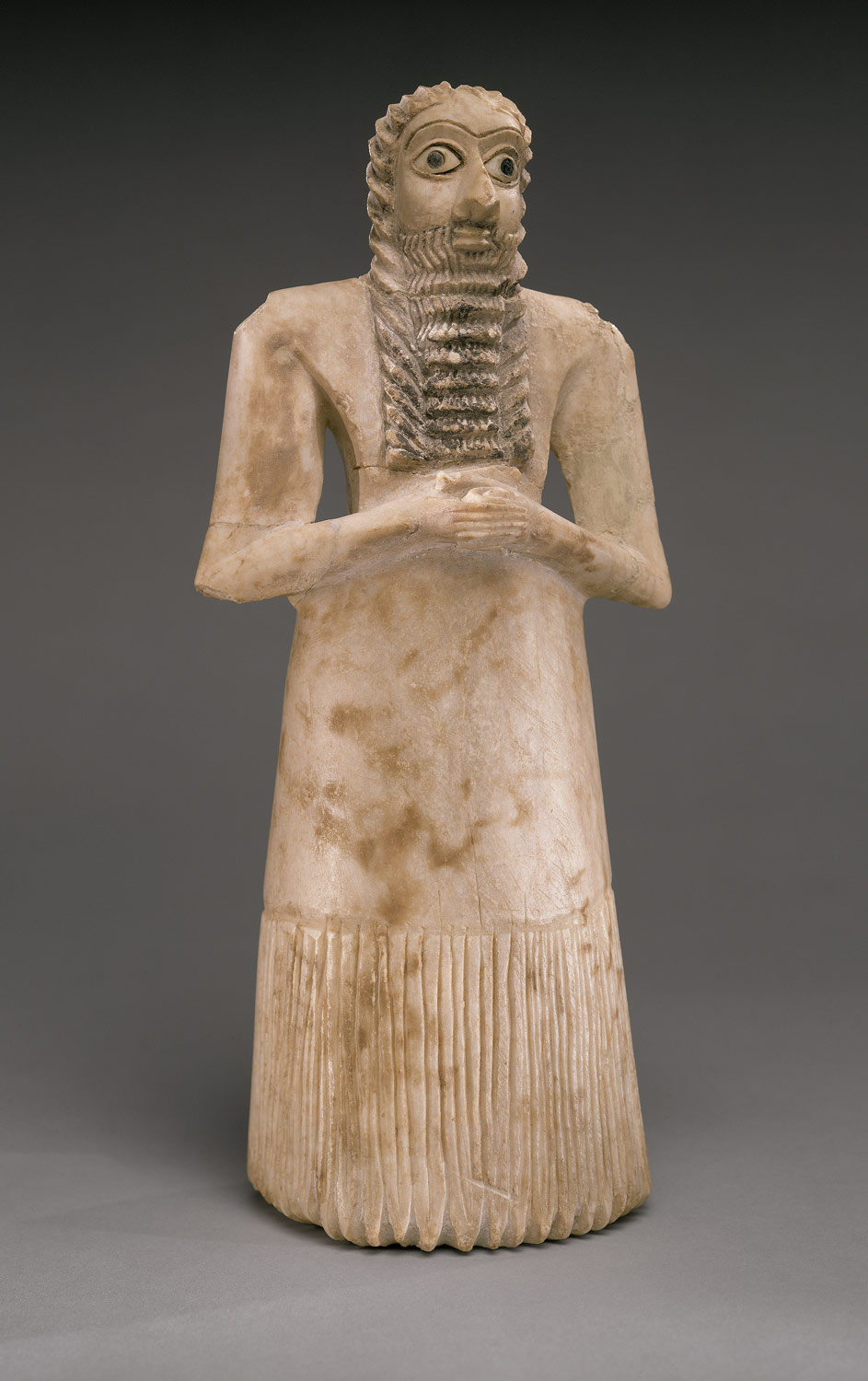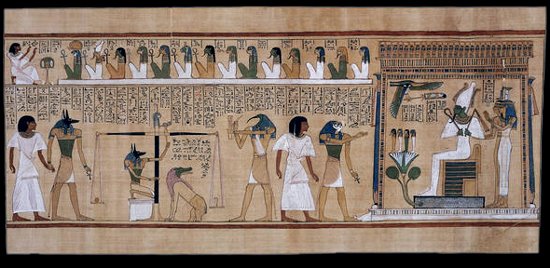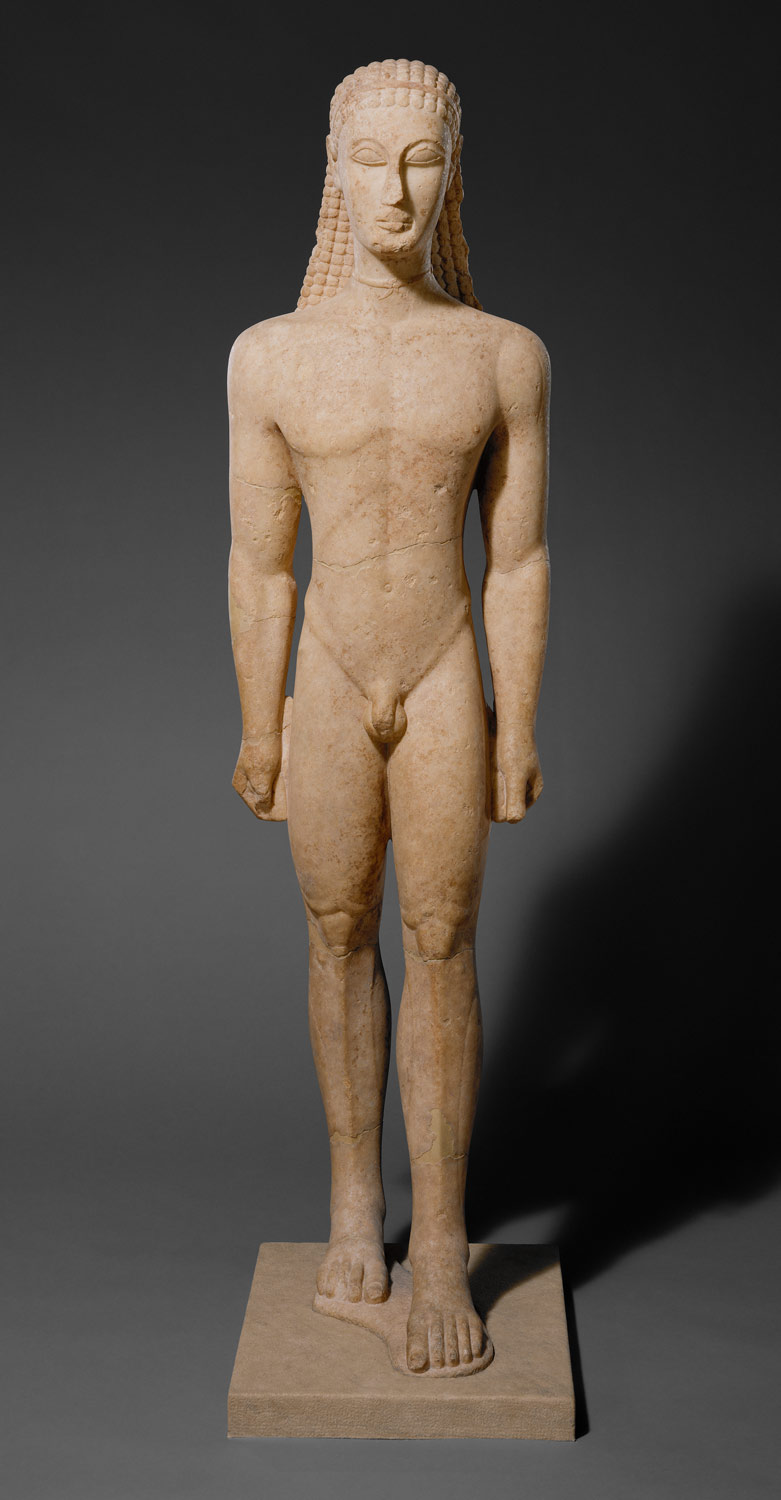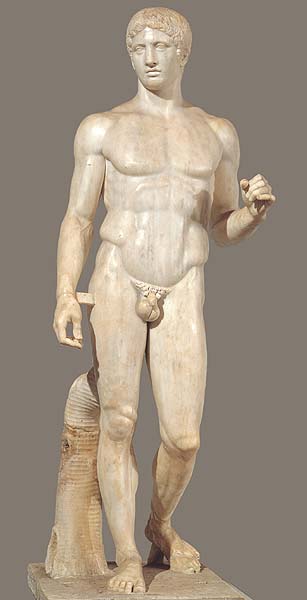In Unit 2 of the Art History course we have learned about and seen many artworks from the Ancient World. The Ancient World is comprised of several civilizations such as Mesopotamian, Egyptian, Greek and Roman societies each having their own different pieces of art work that has been viewed throughout the ages. However, these ancient civilizations may be different but they do share some similarities with one another through their art works.
Greek and Roman Art are statues and figures of young nude warrior men and how their physique and body is idealized and supposed to look like. However, Mesopotamian and Egyptian Art is different from the Greek and Roman Art because Mesopotamian and Egyptian Art are not statues and figures of muscular nude young men instead they have paintings and statues of pharaohs, their hierarchy system, and gods. The Greeks originally created their statues and works of art out of bronze using the lost wax technique so it could later on be melted down if necessary for weapons, tools, and etc. The Romans copied the Greeks works of art but instead of bronze the Romans made their statues out of marble which weighed much more. The Mesopotamian and Egyptian made statues but they were made out of stone and it was not as human compared to the Greeks and Romans, instead the statues were of Gods including human figures mixed with animal parts or pharaohs in loin cloth and fake beards.
Greek and Roman Art and Mesopotamian and Egyptian Art have several similarities and differences. Some examples of Greek and Roman Art is Kouros which represents the ideal physically fit male warrior of the time and later on changes into a more tone, smooth and better looking figure with a difference in hair and stance otherwise known as Doryphoros. Unlike the Greek And Romans, Mesopotamian and Egyptian art portrays figures like Anubis and the Sphinx which are part human and part animal figures, Anubis has the head of a jackal and the body of a man and is the god of the dead. The Sphinx has the head of a human and a body of a lion. Mesopotamian and Egyptian Art also show the hierarchy and the social status with the pharaoh shown to be the biggest and on the top while accompanied by his followers who are of similar or smaller size and the slaves which are the smallest and the lowest of the hierarchy in the pieces of art.
The cultures of the Mesopotamian, Egyptian, Greek, and Roman civilizations were similar due to the way they worship gods and rulers through some of their art works. The artworks reflects the society of the ancient civilizations and shows how they might have been culturally as people. Mesopotamian and Egyptians also portrayed their society through ceramics and stone showing others how the ruler is the highest and the slaves and people were the lowest and also depicts how the ruler is the biggest while the others are smaller. Greek and Roman also portray this among their culture by creating six foot plus tall statues of athletic men even though they were not as tall. This shows how both cultures liked to show their hierarchy and civilizations through their art works to be passed down from generation to generation even though some of these pieces have been through a lot due to the ravages of time it still remains to show how these civilizations strive.
Tag: 9:30 Class – Unit 2 Summary
Unit 2 Summary
Throughout the second unit of Art 1010 I learned a lot about ancient civilizations and how art from those civilizations are similar and how they are different. The four main civilizations that we focused on throughout this unit were Mesopotamia, Ancient Egypt, Ancient Greece, and early Ancient Rome.
Mesopotamia
The first civilization that we focused on in this second unit was Mesopotamia. Mesopotamian art tend to focus more on being symbolic and it was mainly used as a form to worship the Mesopotamian deities. An example of a piece of Mesopotamian art work is the sculpture named The Standing Male Worshiper. The sculpture was used as a stand in for someone was unable to pray to the deity. Due to the fact that it’s only purpose to worship a deity there was no real detail that can really be seen in the physical sculpture. The only detail that can be seen is the stylistic waves of the beard, the abnormally large eyes and nose with its small mouth and the basic detailing at the bottom of its robe.

Ancient Egypt
Another civilization which we learned about during the second unit of Art 1010 was ancient Egypt. Similar to art work from Mesopotamia, Egyptian art work was also centered around religion and worshiping deities. However, unlike Mesopotamian art which only focused on worshiping deities, Egyptian art also focused on people who were divine or had divine power and how they would interact with the deities or how they were judged/treated by the deities. An example of an Egyptian art work is the Last Judgment of Hu-Nefer, From his Tomb. This painting represents deities judging Hu-Nefer, a royal scribe who lived a good and religious life. In the painting It shows Hu-Nefer being lead by Anubis to a scale in which his heart will be weighed against a feather of Mo’at, since his heart is lighter than the feather Hu-Nefer is granted eternal life and is sparred from being eaten by Ammit, As these events occur he divine scribe, Thoth, is writing them down. After having his heart balanced he is lead by Horus to Osiris. In the top register it can be seen that Hu-Nefer is praising a long line of deities for allowing him to have eternal life.

Ancient Greece
Yet another civilization that we learned about during the second unit of art 1010 was ancient Greece. Unlike Mesopotamian and Egyptian art, which focused more on gods and served to honor/respect them, Greek art focused more on humans and more importantly how humans are at the center of moral and social concerns. This shift from a focus of deities to humans is known as Humanism. An example of a piece of art work that shows this shift is the Marble Statue of Kouros. When comparing this Greek sculpture to the Mesopotamian mentioned above we can see major changes. The Marble Statue of Kouros is more detailed then The Standing Male Worshiper, it emphasizes details to the human represented in the artwork by giving them abs and also by adding detail to their face it gives the statue a sense of emotion. There is also a change in the hair style, no facial hair, and a sense of motion thanks to one foot being in front of the other making it so that most of the weight of the figure to be on that leg that is forward, this is known as contrapposto.

Ancient Rome
The final civilization that we talked about during the second unit of art 1010 was early ancient Rome. Like ancient Greece, early ancient Rome also tend to focus more on humans and humanism instead of deities on religion. One similarity yet difference that Roman art has with Greek art is that they both focus on putting detail on the humans represented in their art work but Roman art is far more detailed then Greek art. An example of a Roman art work is Polykleitos, Doryphoros. Unlike the Mesopotamian and Egyptian art works, the Roman statue Polykleitos, Doryphoros focuses more on humans it has a lot of more detailing on the human body, similar to the Marble Statue of Kouros. The hair is less stylistic and more natrualistic, the facial features are not only proportional to each other but also to the entire body of the sculpture, these features also seem to express some form of emotion, something that could not be seen in art from Mesopotamia or Egypt. Another major difference is the stance. most Mesopotamian and Egyptian works of art are of people standing completely straight without any sense of motion in their body unlike Greek and Roman art in which there seems to be motion in all their artworks such as in Polykleitos, Doryphoros. The man represented in this art work is leaning on his right leg instead of standing straight up, this once again shows contrapposto like in the Marble Statue of Kouros,most of the weight of the statue is on the right leg which is why this particular art work has a support on its left leg.

Unit 2 Summary
Unit 2, we finally got into the actual art. We went into the ancient world and discussed the differences and similarities of the art pieces of three different areas; Mesopotamia, Egypt, and Greek-Roman. The differences in the art evolve because of the differences in the culture.
Let’s start with Mesopotamian art. Their art had the ideas of hieratic scale. The more important the person the bigger they were portrayed in the piece. In the Standard of Ur, The biggest person is the king. Even when he’s sitting he is still big enough to break the registar. The servants look like children compared to him. Their art is also made to represent their wins and conquers. To “honor” the strength and power that they have. The people in their art are very stiff in movement and don’t really have identifying details.
In Egyptian art there are many symbols to represent other things. Usually using animals to represent the different Gods that they have. Since there is a different animal to represent each person, it is relatively easy to distinguish between the different people. In the Narmer Palette there are many different animals engraved into it for the different people and this is just a “utensil” to hold makeup. Also the crowns represent the different sections of Egypt (North and South). There also is a component of hieratic scale. The God or King of most importance is the largest in the art piece. With the least significant “character” as the smallest.
In Greek-Roman art is where the idea of humanism starts showing in the art. The belief of humanism is where humans are the center of everything. This belief is present in their nude statues. Many pf the Romans statues were copies of Greek statues however, the Greeks used copper which melted down, and the Romans used stone. The Kroisos is a nude sculpture of a boy used mark and honor a grave. Their standards of beauty were different than anywhere else at that time. They looked at the nude body as beautiful, especially on a young, buff man. The art started out as stiff with no movement but after a while the statues started having curved lines as opposed to straight lines. Also, the art was detailed enough that you were able to see the movement in the muscles through the skin. Most of the sculptures also didn’t have any facial hair, since that wasn’t beautiful, unless you were really important and didn’t have any time to shave.
Unit #2 Summary
From the artworks discussed in Unit 2, ancient civilization implemented their culture and important aspects of their society into their art. The distinction between ancient Greece, Rome, and Egypt, and Mesopotamia artwork is shown to the various symbols and expressions presented. However, despite existing during separate time periods, some of these civilizations, such as Egypt and Mesopotamia, display similar importance over beliefs and tradition.
When comparing the Standing Male Worshipper (2900 – 2600 BCE) and the Statue of Khafre (approx. 2500 BCE) from ancient Egypt and Mesopotamia, the posture of the statues and symbolic features give mention to the spiritual side of their culture. The Standing Male Worshipper was used by Sumerians in place of themselves to consistently pray to the deities. The way the eyes, arms, and shoulders are positioned on the worshipper displays an attentive and non-threatening stance which was meant to show the intended god the person’s dedication and humbleness. Same with the Statue of Gudea, Gudea is positioned towards his subjects in a humble, non-threatening stance. This can be deducted from his hands clasped in front of him; a sign of being peaceful and respectful. His eyes, while not as open of the Standing Male Worshipper, gives the viewer a sense of understanding and makes them feel like they have his undivided attention. Another feature that these statues have is their design. Both have an idealistic look to them that makes them appear unhuman like. It gives the statue a divine feel to them.
The subject that has been brought up during this unit is humanism. Humanism became prominent in ancient Greek and Roman artwork unlike ancient Egypt and Mesopotamia artwork. Especially in Greek art, humanism showed more emphasis on the physical, emotional side to human nature while Mesopotamia based their art on the religious, spiritual side of human nature. When comparing the Statue of Khafre (2750 BCE) to the Dying Gaul (230 – 220 BCE), their differences can be easily pointed out. The Statue of Khafre, a burial statue for the Pharaoh Khafre, lacks any naturalistic features. The statue presents a powerful, godly display of the pharaoh. This was done purposely to present him as a divine-like being. The Dying Gaul however is a stark contrast. This statue presents this Gaul in a compromising position. He’s looks to be injured and the pain and exhaustion is clearly shown in his face. His body’s position on the floor gives a state of vulnerability and tiredness. The observations from these artworks shows the human side of the Greek and Roman art and the spiritual side of Egyt and Mesopotamia art.
Something that was very distinct between the Greek and the Romans was their architectural style. All the temples in ancient Greece and ancient Rome served the purpose of paying tribute to the gods. However, the sizes of their temples were different. Greek temples were built huge to house the statues of their deities in addition to conducting ceremonies and rituals. In contrast, Roman temples were built much smaller as the ceremonies and deities statues took place outside in front of the temples. To make a comparison, take for example The Parthenon (447 – 432 BCE) versus the Villa of Publius Fannius Synistor (50 – 40 BCE). From a quick glance, one can determine that the Parthenon is enormous. On the inside, the temple looks like it was meant for the purpose of holding functions of sorts. However, the Villa of Publius Fannius Synistor was meant to create a bigger landscape within a small confined room. Using linear perspective, the Roman accomplished the goal of giving the illusion of being in another landscape. The way the artwork aligns with the vanishing point gives the flat surface of the wall a new 3-dimensional viewpoint.
Unit 2 Summary
The culture of what is called the ‘near east’ had a kind of reverence for the mythical. In that they were much the equivalents of ants from the perspective of personified nature. Much of their art reflected their focus on appeasing the forces of nature. The Babylonian Map of the World was used to represent mythological figures through an approximate mapping of the ‘near east’.
Unlike the ‘near east’, Egypt as a whole is easier to refer to as a singular entity. Egyptian art served the purpose of the mythological: much the same as the cultures of the ‘near east’ (this is my first example). However, their relationship with their divinity–while still stressed–was more personal. Much of their crafts served some ceremonial purpose that most citizens took part in. Most abundant of these crafts being the assortment of funeral ornamentation. Being that divinity and all things spiritual were so interwoven with the Egyptian sense of self: artists were focused more on the abstract–the idea of things (Hard stone group statue of Ramses II with Osiris, Isis, and Horus ).
Greece’s mythology took a humanistic approach. The mythological figures are often some exaggerated expression of human nature. Greece, while having a varying amount of styles in their art, is most prominently known for their focus on realism. The Greeks had greater inspiration in the spirit and potential of humanity: with a fondness for portraying reality as is. While Mycenaean art still took after much of what came before with Egypt ((Kouros) this is my second example): Greece would eventually become synonymous with realism (Doryphoros).
Rome took much of its inspiration from Greece but Roman craftsmen would still appreciate the use of un-detailed figures for the sake of a theme/concept ((Ludovisi Battle Sarcophagus) this is my third example).
All these cultures are super cool. They all have similarities. They also have lots of differences. It all makes me wonder if the united states will be around for something as long as five thousand years. Perhaps I am looking at it wrong: an America of a different name will exist.
It truly makes me wonder in awe at the kind of time and effort it took to build such constructs as the pyramids. The Colosseum is also such a huge undertaking. Christianity apparently took of real huge by the time Rome was a shambling corpse. Christianity is a huge religion; religion is huge. Makes me wonder how things got so huge in so small a time.





